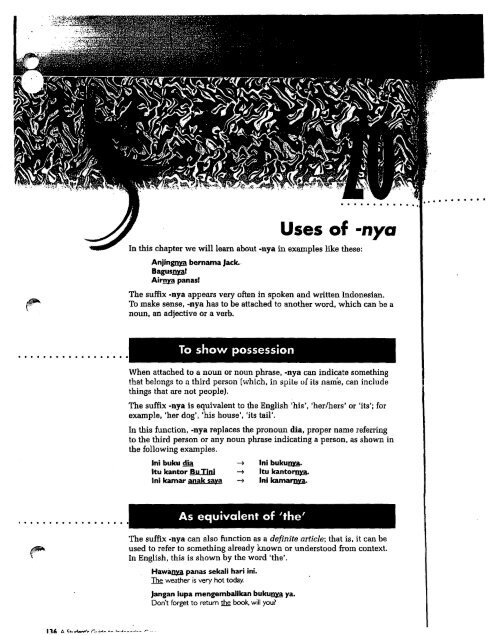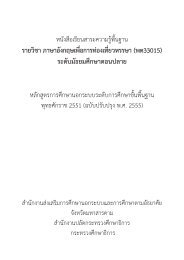bahasa indonesia
djenar-2003-a-students-guide-to-indonesian-grammar-oxford
djenar-2003-a-students-guide-to-indonesian-grammar-oxford
- No tags were found...
You also want an ePaper? Increase the reach of your titles
YUMPU automatically turns print PDFs into web optimized ePapers that Google loves.
Uses of -nyu<br />
In this chapter we will learn about -nya in examples like these:<br />
Anjfnm bernama Jack..<br />
Bagus-<br />
Air- panas!<br />
The suffix -nya appears very often in spoken and written Indonesian.<br />
To make sense, -nya has to be attached to another word, which can be a<br />
noun, an adjective or a verb.<br />
I<br />
When attached to a noun or noun phrase, -nya can indicate something<br />
that belongs to o third person [which, in spite of iis namb, can include<br />
things that are not people).<br />
The suffix -nya is equivalent to the English 'his', 'her/hers' or 'its'; for<br />
example, 'her dog', 'his house', 'its tail'.<br />
In this function, -nya replaces the pronoun dia, proper name referring<br />
to the third person or any noun phrase indicating a person, as shown in<br />
the following examples.<br />
Ini buku &<br />
Itu kantor Bu Tini<br />
Ini kamar anak saYa<br />
Inibukuma.<br />
+ Itu kantorm.<br />
+ Ini kamama<br />
f@=<br />
The suffix -nya can also function as a definite article; that is, it can be<br />
used to refer to something already known or understood from context.<br />
In English, this is shown by the word 'the'.<br />
Hawam panas sekali hari ini.<br />
The weather is very hot today.<br />
Jangan lupa mengembalikan bukum ya.<br />
Don't forget to return the book, will you?



